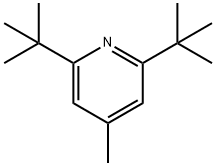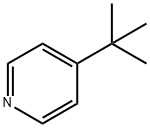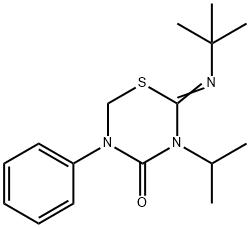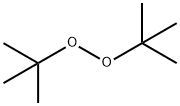2,6-Di-tert-butyl-4-methylpyridine
- CAS NO.:38222-83-2
- Empirical Formula: C14H23N
- Molecular Weight: 205.34
- MDL number: MFCD00006305
- EINECS: 253-834-4
- SAFETY DATA SHEET (SDS)
- Update Date: 2024-12-04 20:40:58

What is 2,6-Di-tert-butyl-4-methylpyridine?
Chemical properties
light yellow powder
The Uses of 2,6-Di-tert-butyl-4-methylpyridine
2,6-Di-tert-butyl-4-methylpyridine is used for the generation of enol triflates from ketones using trifluoromethanesulfonic anhydride. It is also used in the synthesis of 1,2-dihydro-2-silanaphthalene derivatives, as base in PtCl4-catalyzed cyclization reactions of homopropargyl azide derivatives and in diastereoselective synthesis of β-thiomannopyranosides.
The Uses of 2,6-Di-tert-butyl-4-methylpyridine
2,6-Di-tert-butyl-4-methylpyridine has been used:
- in the synthesis of 1,2-dihydro-2-silanaphthalene derivatives
- as base in PtCl4-catalyzed cyclization reactions of homopropargyl azide derivatives
- diastereoselective synthesis of β-thiomannopyranosides
Synthesis Reference(s)
The Journal of Organic Chemistry, 41, p. 3034, 1976 DOI: 10.1021/jo00880a027
General Description
2,6-Di-tert-butyl-4-methylpyridine is a sterically hindered, non-nucleophilic base which distinguishes between protonic and Lewis acids. It also enables the direct high-yield conversion of aldehydes and ketones to vinyl triflates. It inhibits desilylation and hydration of the products during GaCl3-catalyzed ortho-ethynylation of phenol.
Purification Methods
A possible impurity is 2,6-di-tert-butyl-4-neopentylpyridine. Attempts to remove coloured impurities directly by distillation, acid-base extraction or treatment with activated charcoal were unsuccessful. Pure material is obtained by dissolving 0.3mole of the alkylpyridine in pentane (150mL) and introducing it at the top of a cold water jacketed chromatographic column (40 x 4.5cm) (cooling is necessary because the base in pentane reacts exothermically with alumina) containing activated and acidic alumina (300g). The column is eluted with pentane using a 1L constant pressure funnel fitted at the top of the column to provide slight pressure. All the pyridine is obtained in the first two litres of eluent (the progress of elution is monitored by spotting a fluorescent TLC plate and examining under short wave UV light—a dark blue spot is evidence for the presence of the alkylpyridine). Elution is complete in 1hour. Pentane is removed on a rotovap with 90-93% recovery yielding a liquid which solidifies on cooling, m 31-32o, and the base can be distilled. The HPtCl6 salt has m 213-314o(dec), and the CF3SO3H salt has m 202.5-203.5o (from CH2Cl2). [Anderson & Stang Org Synth Coll Vol VII 144 1981, Beilstein 20/6 V 190.]
Properties of 2,6-Di-tert-butyl-4-methylpyridine
| Melting point: | 33-36 °C (lit.) |
| Boiling point: | 233 °C (lit.) |
| Density | 1,476 g/cm3 |
| refractive index | n |
| Flash point: | 183 °F |
| storage temp. | 2-8°C |
| solubility | ethanol: soluble5%, clear to slightly hazy, colorless to dark yellow |
| form | Liquid or Low Melting Solid |
| pka | 6.88±0.10(Predicted) |
| color | brown |
| Water Solubility | Sparingly soluble in water. Soluble in ethanol, acetic acid and diethyl ether. |
| Sensitive | Air & Light Sensitive |
| BRN | 130503 |
| CAS DataBase Reference | 38222-83-2(CAS DataBase Reference) |
Safety information for 2,6-Di-tert-butyl-4-methylpyridine
| Signal word | Warning |
| Pictogram(s) |
 Exclamation Mark Irritant GHS07 |
| GHS Hazard Statements |
H302:Acute toxicity,oral H315:Skin corrosion/irritation H319:Serious eye damage/eye irritation H335:Specific target organ toxicity, single exposure;Respiratory tract irritation |
| Precautionary Statement Codes |
P261:Avoid breathing dust/fume/gas/mist/vapours/spray. P264:Wash hands thoroughly after handling. P264:Wash skin thouroughly after handling. P270:Do not eat, drink or smoke when using this product. P301+P312:IF SWALLOWED: call a POISON CENTER or doctor/physician IF you feel unwell. P302+P352:IF ON SKIN: wash with plenty of soap and water. P305+P351+P338:IF IN EYES: Rinse cautiously with water for several minutes. Remove contact lenses, if present and easy to do. Continuerinsing. |
Computed Descriptors for 2,6-Di-tert-butyl-4-methylpyridine
| InChIKey | HVHZEKKZMFRULH-UHFFFAOYSA-N |
New Products
4-Fluorophenylacetic acid 4-Methylphenylacetic acid N-Boc-D-alaninol N-BOC-D/L-ALANINOL Tert-butyl bis(2-chloroethyl)carbamate 3-Morpholino-1-(4-nitrophenyl)-5,6-dihydropyridin- 2(1H)-one Furan-2,5-Dicarboxylic Acid Tropic acid S-2-CHLORO PROPIONIC ACID ETHYL ISOCYANOACETATE 2-Bromo-1,3-Bis(Dimethylamino)Trimethinium Hexafluorophosphate (6-METHYL-[1,3]DITHIOLO[4,5-b]QUINOXALIN-2-ONE INDAZOLE-3-CARBOXYLIC ACID 4-IODO BENZOIC ACID (2-Hydroxyphenyl)acetonitrile 4-Bromopyrazole 5,6-Dimethoxyindanone 2-(Cyanocyclohexyl)acetic acid 4-methoxy-3,5-dinitropyridine 2-aminopropyl benzoate hydrochloride 1-(4-(aminomethyl)benzyl)urea hydrochloride diethyl 2-(2-((tertbutoxycarbonyl)amino) ethyl)malonate tert-butyl 4- (ureidomethyl)benzylcarbamate Ethyl-2-chloro((4-methoxyphenyl)hydrazono)acetateRelated products of tetrahydrofuran








You may like
-
 2,6-Di-tert-butyl-4-methylpyridine CAS 38222-83-2View Details
2,6-Di-tert-butyl-4-methylpyridine CAS 38222-83-2View Details
38222-83-2 -
 2,6-Di-tert-butyl-4-methylpyridine CAS 38222-83-2View Details
2,6-Di-tert-butyl-4-methylpyridine CAS 38222-83-2View Details
38222-83-2 -
 2,6-Di-tert-butyl-4-methylpyridine CAS 38222-83-2View Details
2,6-Di-tert-butyl-4-methylpyridine CAS 38222-83-2View Details
38222-83-2 -
 1975-50-4 98%View Details
1975-50-4 98%View Details
1975-50-4 -
 2-HYDROXY BENZYL ALCOHOL 98%View Details
2-HYDROXY BENZYL ALCOHOL 98%View Details
90-01-7 -
 2-Chloro-1,3-Bis(Dimethylamino)Trimethinium Hexafluorophosphate 221615-75-4 98%View Details
2-Chloro-1,3-Bis(Dimethylamino)Trimethinium Hexafluorophosphate 221615-75-4 98%View Details
221615-75-4 -
 14714-50-2 (2-Hydroxyphenyl)acetonitrile 98+View Details
14714-50-2 (2-Hydroxyphenyl)acetonitrile 98+View Details
14714-50-2 -
 118753-70-1 98+View Details
118753-70-1 98+View Details
118753-70-1